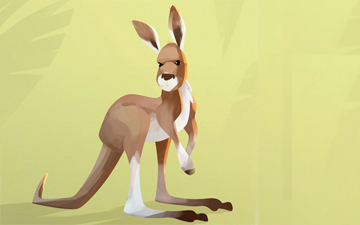The Red Kangaroo (Macropus rufus) is the largest of all kangaroos, the largest mammal native to Australia, and the largest surviving marsupial. It is found across mainland Australia, avoiding only the more fertile areas in the south, the east coast, and the northern rainforests.
This species is a very large kangaroo with short, red-brown fur, fading to pale buff below and on the limbs. It has long, pointed ears and a squared-off muzzle. Females are smaller than males and are blue-grey with a brown tinge, pale grey below, although arid zone females are coloured more like males. It has two forelimbs with small claws, two muscular hind-limbs, which are used for jumping, and a strong tail which is often used to create a tripod when standing upright.
The Red Kangaroo’s legs work much like a rubber band. The males can leap over 9 metres (30 ft) in one leap.[3]
Males grow up to a body length of 1.4 metres (4 ft 7 in) long and weigh up to 85 kilograms (190 lb). Females reach a body length of up to 1.1 metres (3 ft 7 in) long and weigh up to 35 kilograms (77 lb). Tails can be from 0.9 to 1 metre (3.0–3.3 ft) long. The average Red Kangaroo stands approximately 1.5 metres (4 ft 11 in) tall.[4] Accounts of sizes greater than this are not uncommon, with some large males reportedly reaching approximately 2 metres (6 ft 7 in).
The Red Kangaroo maintains its internal temperature at a point of homeostasis about 36 °C (97 °F) using a variety of physical, physiological, and behavioural adaptations. These include having an insulating layer of fur, being less active and staying in the shade when temperatures are high, panting, sweating, and licking its forelimbs.
The Red Kangaroo’s range of vision is approximately 300°, due to the position of its eyes.[citation needed]
(From Wikipedia, January 23, 2010)
– – –
Macropus rufus is the largest living marsupial. Males range in total body length from 1,300 to 1,600 mm and females from 850 to 1,050 mm. Tail length is from 1,000 to 1,200 mm for males and 650 to 850 mm for females. They may weigh as much as 90 kg and may reach 1.8 meters in height when standing. Coat color is usually reddish brown in males and bluish gray in females, although these colors are reversed in some areas, with females being reddish and males blue-gray. Red kangaroos are robustly built, with large, well-muscled tails and powerful hindquarters. The tail is strong enough to support the kangaroo’s body weight, acts as a balance when jumping, and is used, with the two legs, to form a tripod for resting. The second and third toes of red kangaroos are fused and shaped into a grooming claw. Their foreshortened upper limbs terminate in clawed paws used with great dexterity in eating, grooming, and self-defense. Females have a forward facing pouch and 4 mammae. (Nowak, 1991; Snelling, Sept-Nov 1988)
(From Animal Diversity Web via EOL, January 23rd, 2010)
– – –




